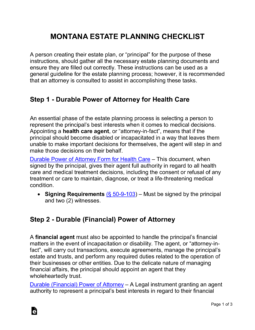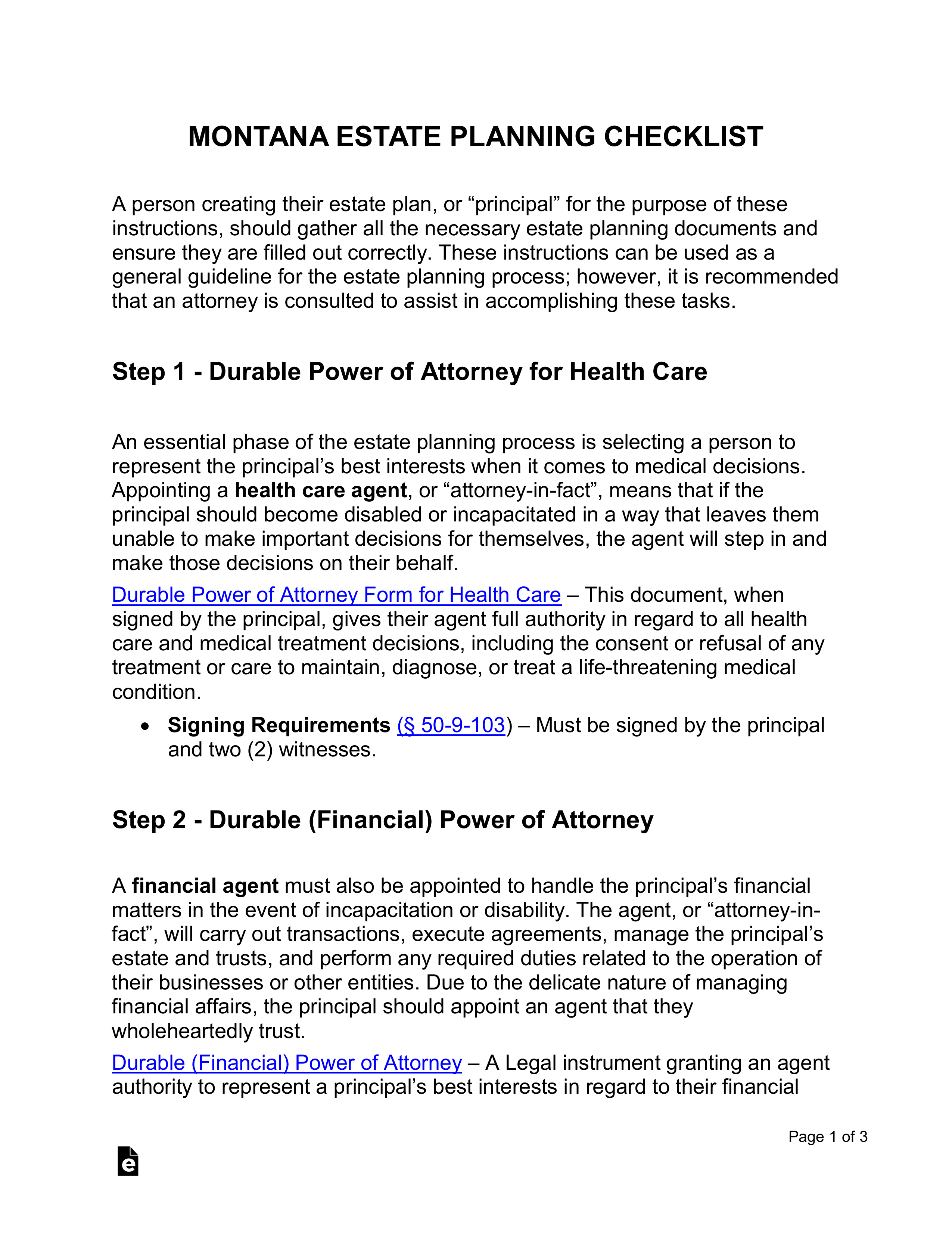Updated March 05, 2024
A Montana estate planning checklist is an organizational tool to keep track of what a person needs to complete to get their estate in order. To ensure that one’s estate will be in good hands in the unfortunate event of their death or incapacitation, an estate plan should be put into place. This will include constructing a Durable Power of Attorney for Health Care, a Durable Financial Power of Attorney, a Last Will and Testament and/or a Living Trust. These forms include all the creator’s wishes, intentions, and instructions relating to their medical care, their finances, and the distribution of their assets.
How to Create an Estate Plan in Montana (6 steps)
- Durable Power of Attorney for Health Care
- Durable (Financial) Power of Attorney
- List of Assets and Liabilities
- Beneficiaries
- Last Will and Testament / Living Trust
- Store Documents
A person creating their estate plan, or “principal” for the purpose of these instructions, should gather all the necessary estate planning documents and ensure they are filled out correctly. These instructions can be used as a general guideline for the estate planning process; however, it is recommended that an attorney is consulted to assist in accomplishing these tasks.
1. Durable Power of Attorney for Health Care
An essential phase of the estate planning process is selecting a person to represent the principal’s best interests when it comes to medical decisions. Appointing a health care agent, or “attorney-in-fact,” means that if the principal should become disabled or incapacitated in a way that leaves them unable to make important decisions for themselves, the agent will step in and make those decisions on their behalf.
Durable Power of Attorney Form for Health Care – This document, when signed by the principal, gives their agent full authority in regard to all health care and medical treatment decisions, including the consent or refusal of any treatment or care to maintain, diagnose, or treat a life-threatening medical condition.
- Signing Requirements – Must be signed by the principal and two (2) witnesses.[1]
2. Durable (Financial) Power of Attorney
A financial agent must also be appointed to handle the principal’s financial matters in the event of incapacitation or disability. The agent, or “attorney-in-fact”, will carry out transactions, execute agreements, manage the principal’s estate and trusts, and perform any required duties related to the operation of their businesses or other entities. Due to the delicate nature of managing financial affairs, the principal should appoint an agent that they wholeheartedly trust.
Durable (Financial) Power of Attorney – A legal instrument granting an agent authority to represent a principal’s best interests in regard to their financial affairs. The document remains in full effect when the principal is unable to handle these important decisions.
- Signing Requirements – Must be signed by the principal and acknowledged by a notary public.[2]
Financial Powers Allowed:
- Real Property[3]
- Tangible personal property[4]
- Stocks and bonds[5]
- Commodities and options[6]
- Banks and other financial institutions[7]
- Operation of entity or business[8]
- Insurance and annuities[9]
- Estates, trusts, and other beneficial interests[10]
- Claims and litigation[11]
- Personal and family maintenance[12]
- Benefits from governmental programs or civil or military service[13]
- Retirement plans[14]
- Taxes[15]
- Gifts[16]
3. List of Assets and Liabilities
4. Beneficiaries
5. Last Will and Testament / Living Trust
It is worth mentioning again that an attorney should be requested when deciding which document would better serve the principal – a Last Will and Testament, a Revocable Living Trust, or both. Each instrument could benefit the principal in different ways.
Last Will and Testament – The principal, or testator as they are referred to in a Will, will provide instructions regarding the distribution of their estate to named beneficiaries after they die. After the testator’s death, this document must be reviewed by probate court to determine its authenticity and validity. If it is approved by the court to be legitimate, the executor (person selected by the testator to carry out the Will’s instructions) will distribute the estate.
- Signing Requirements – Testator and two (2) witnesses.[17]
(Revocable) Living Trust – Similar to a Will, a Revocable Living Trust ensures that a grantor’s (principal) estate is divided properly amongst the beneficiaries after their death. The Trust acts as an entity into which the grantor can place all or a part of their estate, ultimately transferring ownership of these assets to the Trust. The grantor continues to benefit from their assets during their lifetime, and typically names themselves trustee of the entity. The main difference between a Will and a Living Trust is that a Trust will not be reviewed by probate court nor will it be made public record after the grantor’s death.
- Signing Requirements – Not specifically mentioned; however, it is highly recommended to have the document signed by a witness and a notary public.
6. Store Documents
Montana Estate Planning Laws
- Durable Power of Attorney for Health Care – § 72-5-501; § 72-5-502
- Durable (Financial) Power of Attorney – § 72-31 Part 3
- Last Will and Testament – § 72-5 Part 5
- Revocable Living Trust – § 72-38 Part 6


